 |
Mantley Field LaitheThursday, 10th October 2002, Malham, North Yorkshire |
![]()
![]()
![]()
![]() Rocks |
History |
Workshop |
Links |
Home Page
Rocks |
History |
Workshop |
Links |
Home Page
![]()
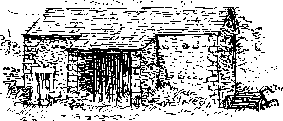 No matter how thoroughly I might think I've covered the aspects of a place there's always some detail that I've missed. Having drawn Mantley Field Laithe for my forthcoming booklet Malham Magic I now feel that I need some detail on exactly what type of stone was used in its construction.
No matter how thoroughly I might think I've covered the aspects of a place there's always some detail that I've missed. Having drawn Mantley Field Laithe for my forthcoming booklet Malham Magic I now feel that I need some detail on exactly what type of stone was used in its construction.Laithe is the old Yorkshire word for a barn.
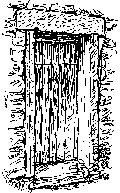 Stop and examine a stone wall like this and it's surprising how much more you'll see, especially if you're lucky enough to be in the company of an experienced geologist, as I am today. Neil Aitkinhead, formerly of the British Geological Survey, soon points out the shell fragments that make up the carboniferous limestone of its walls.
Stop and examine a stone wall like this and it's surprising how much more you'll see, especially if you're lucky enough to be in the company of an experienced geologist, as I am today. Neil Aitkinhead, formerly of the British Geological Survey, soon points out the shell fragments that make up the carboniferous limestone of its walls.I'm aiming to include the essence of Malhamdale in one small slim volume but I realise that I could have written the whole book about this one barn; its history, natural history and geology.
Some blocks contain fragments of sea lilies which resemble broken up penne pasta.
Brachiopods
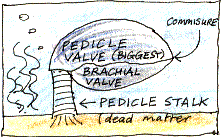 At first sight brachiopods, one or two of which can be seen in the walls of this barn, might seem to resemble bivalve shells, like oysters or cockles, but they're completely unrelated. One of the distinguishing features of a a brachiopod is a stem that anchors the creature to the seabed. This isn't often preserved and what you usually see is an impression of the thick, often ribbed, shell.
At first sight brachiopods, one or two of which can be seen in the walls of this barn, might seem to resemble bivalve shells, like oysters or cockles, but they're completely unrelated. One of the distinguishing features of a a brachiopod is a stem that anchors the creature to the seabed. This isn't often preserved and what you usually see is an impression of the thick, often ribbed, shell.One hundred species of brachiopods survive today but in most marine environments bivalves have replaced them.
Corals
 We find two species of corals, both solitary and colonial. Again the colonial
corals remind me of pasta, this time of the thickish strands in a loose bunch
of spaghetti. If seen in cross-section, as they often are, these colonies
have a spotted appearance. When they are grouped more closely together they have a honeycomb
appearance, as in my sketch above.
We find two species of corals, both solitary and colonial. Again the colonial
corals remind me of pasta, this time of the thickish strands in a loose bunch
of spaghetti. If seen in cross-section, as they often are, these colonies
have a spotted appearance. When they are grouped more closely together they have a honeycomb
appearance, as in my sketch above. Rugose corals were horn-shaped, fixed by their pointed end in the seabed. Rugose means wrinkled, ridged or folded. Seen in section a solitary rugose corals resembles the pattern on a dartboard, divided by septa.
Cornerstones
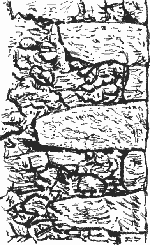 While the walls are made of rough knobbly pieces of limestone picked up from the stream or from the fields where they might have been dumped in ice age deposits, the cornerstones are made from a coarse-grained sandstone, most likely from the local Pendle Grit, which outcrops at the other side of the stream and on the moor beyond Gordale.
While the walls are made of rough knobbly pieces of limestone picked up from the stream or from the fields where they might have been dumped in ice age deposits, the cornerstones are made from a coarse-grained sandstone, most likely from the local Pendle Grit, which outcrops at the other side of the stream and on the moor beyond Gordale.There's little or no trace of bedding in these corner blocks so it is likely that they are turbidites, sediments which settled out of suspension on the continental slope following underwater avalanches. This was at a time, some 320 million years ago, when the river deltas that would produce the millstone grit of the Pennines were beginning to advance from the north to fill in the basin in which the carboniferous limestone had been laid down.
Owl Window
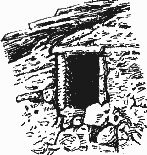 In contrast the flagstone 'slates' on the roof of the barn show traces of bedding including 'minor dark micaceous lamination', as Neil describes it, suggesting that they were laid down in much shallower water. Similar sandstones are found in the Yoredale series.
In contrast the flagstone 'slates' on the roof of the barn show traces of bedding including 'minor dark micaceous lamination', as Neil describes it, suggesting that they were laid down in much shallower water. Similar sandstones are found in the Yoredale series.'Judging from the geological maps,' suggests Neil, 'the nearest would be Fountains Fell or around Parsons Pulpit NE of Malham Tarn.'
An owl window was included in the barn, which was probably built in the nineteenth or late eighteenth century. Barn owls were encouraged to nest there to help control the number of rats and mice in the barn.
The Pennines and adjacent areas
 Neil Aitkinhead is one of the authors of the new edition of The Pennines and adjacent areas published this year by the British Geological Survey, ISBN 0-85272-424-1, price £18.00.
Neil Aitkinhead is one of the authors of the new edition of The Pennines and adjacent areas published this year by the British Geological Survey, ISBN 0-85272-424-1, price £18.00.This book covers the Pennines from Swaledale in the north to the Peak District in the south and the adjacent areas (including the coalfields) from Liverpool to Morecambe on the Lancashire side of the Pennines and from York to Nottingham on the Yorkshire side. There are scores of colour photographs and diagrams. With my interest in past landscapes I'm particularly impressed by the way that our familiar local rocks have been linked in colour maps to the paleo-environments - deserts, forests, deltas, seas, ice fields, even the odd volcano - in which they formed.
![]()
Richard Bell,
wildlife illustrator
E-mail; 'richard@willowisland.co.uk'
![]() Next page |
Previous page |
This day last year |
This month |
Nature Diary |
Home Page
Next page |
Previous page |
This day last year |
This month |
Nature Diary |
Home Page
![]()